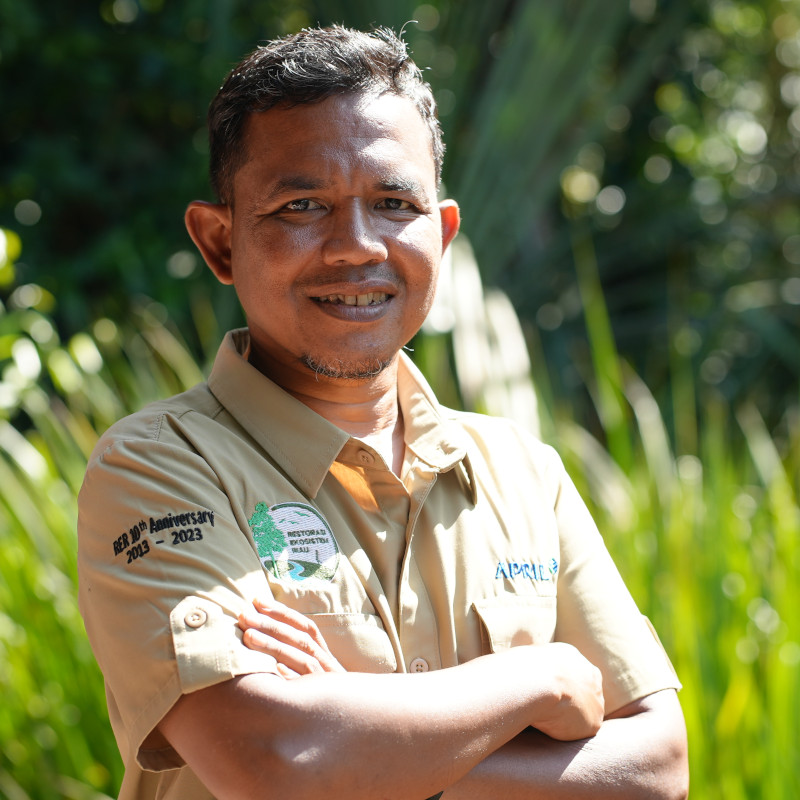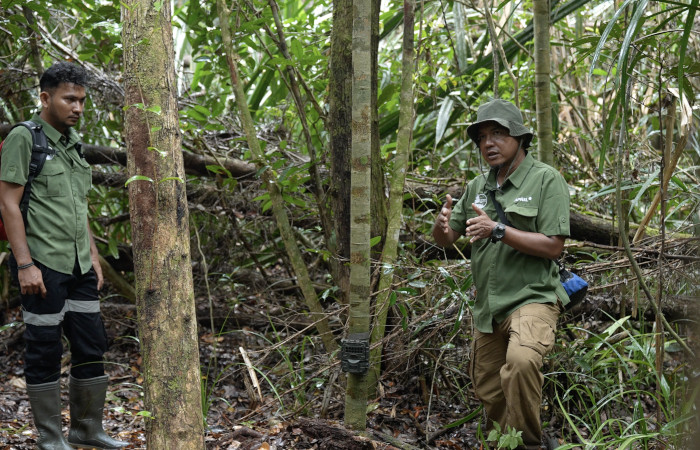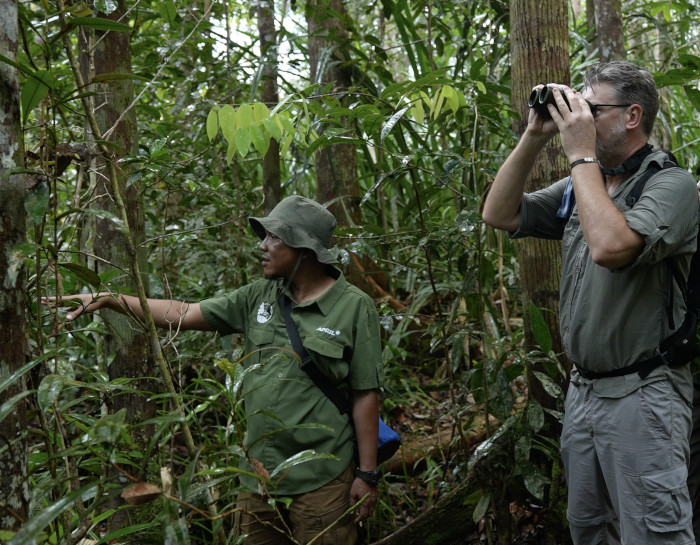July 24, 2025
The team at Restorasi Ekosistem Riau (RER) is just as diverse as the landscape they are working to protect. Hailing from different backgrounds and specializing in a range of disciplines, their combined knowledge, passion, and expertise allows us to approach conservation challenges from multiple perspectives. In this article, we hear from Biodiversity Conservation Manager Yoan Dinata (also known as Pak Nata), who reveals his daily activities and his motivation for working in this field.
“I’ve always felt a deep connection to nature,” says Pak Nata. “It’s not just a job for me; it’s a calling that’s been with me since I was young.” That calling began in the forests of Jambi, Sumatra, where he grew up exploring nature alongside his father. “I vividly recall the wonder of seeing a Sunda pangolin up close, or the quiet fascination of spotting a slow loris in the trees. And the calls of the ungko (agile gibbon) were a constant soundtrack to my days, along with hearing so many captivating stories about tigers from my father.”
These early experiences instilled in him a lifelong respect for the forest and its wild inhabitants – especially the Sumatran tiger. Now, as an adult, Pak Nata is working to preserve these wonders for future generations, and adding his own chapter to those stories of tigers from his youth.

The Role of a Biodiversity Conservation Manager
Pak Nata joined RER in July 2024, drawn by the project’s holistic and ambitious approach to ecosystem restoration. As he explains, “RER’s commitment to restoring and managing a vast, ecologically vital landscape truly resonated with my long-standing passion for large-scale conservation impact.”
His role at RER is both strategic and hands-on. “As the Biodiversity Conservation Manager, my daily activities revolve around leading and enabling my team to achieve our conservation objectives,” he explains. “This involves actively supervising and supporting them throughout the entire process of planning and implementing our ecological research, monitoring, and species/habitat management initiatives.”
Read also: RER Biodiversity Survey
Pak Nata also plays a role in compiling scientific reports and activity documentation, ensuring that the conservation work on the ground is effectively communicated to stakeholders and contributes to the wider body of ecological knowledge.

Working to Secure Protection
Pak Nata’s journey is inextricably linked to the story of the Sumatran tiger. Since 2000, he has studied and protected these critically endangered big cats, through work that includes the development of a groundbreaking monitoring program in Kerinci Seblat National Park.
“That program was pivotal,” he says. “We’ve been able to generate reliable population estimates that are crucial for conservation planning, effectively identify key tiger habitats and corridors that require urgent protection, and… our findings have been instrumental in informing anti-poaching strategies and advocating for stronger policy enforcement.”
His connection to these animals is deeply personal. “What truly ignites my dedication is witnessing their incredible resilience against overwhelming odds… The thought of a Sumatra without its tigers is simply unthinkable,” he says.
Assessing the Ecosystem Role Played by Tigers
At RER, Pak Nata’s work contributes directly to the long-term survival of the species. “By restoring the forest’s overall health and intricate biodiversity, we’re building a more secure and sustainable future for Sumatran tigers,” he explains
Tigers, as apex predators, play a vital ecological role. As Pak Nata explains, “protecting Sumatran tigers is absolutely essential because they are a critically endangered keystone species… Their protection also provides crucial ecosystem services like clean water and air, directly benefiting human communities.”
Tigers help regulate populations of herbivores like deer and forest pigs. This regulation prevents overgrazing and promotes the regeneration of forest vegetation, which in turn stabilizes the forest ecosystem and supports both carbon storage and water filtration – ecosystem services that are essential to the forest, and indirectly benefit humans.

Challenges on the Ground
The dynamic nature of a restored forest environment requires constant adaptation to strategies and approaches. “We’re working within a restored forest, meaning conditions are constantly evolving,” says Pak Nata. “What works today might need adjustment tomorrow due to changes in climate, invasive species incursions, or unexpected shifts in wildlife behavior.”
Another hurdle is maintaining high-quality, consistent data across a team working on myriad operations in the field. “With multiple team members collecting diverse types of data… there’s always a risk of inconsistencies or errors that could compromise the accuracy of our reports,” explains Pak Nata.
In response to these challenges, Pak Nata doubles down on his commitment to a rigorous scientific approach. Together with his team, he continues to refine fieldwork and data methodology, embracing flexibility and learning from each step of the restoration process.
Looking to the Future
Pak Nata’s vision for the future is both hopeful and determined. “I envision Sumatran tigers moving off the critically endangered list,” he explains, “freely roaming vast, interconnected, and healthy forest landscapes.” He sees his work at RER as a major building block in this development process, noting “it provides the data needed for effective, long-term conservation strategies.”
Pak Nata’s hopes extend beyond tigers to the broader ecosystem: “I hope to see peatland forest ecosystems at RER fully recover,” he says. “This means degraded areas becoming resilient, biodiverse havens that actively fight climate change by sequestering carbon and reducing fire risks.”
Through his work at RER, Pak Nata is bringing his vision for the future into focus.